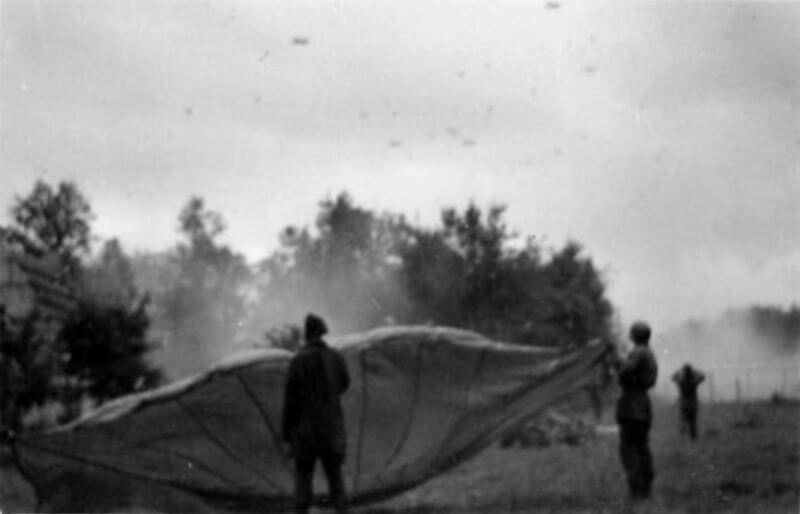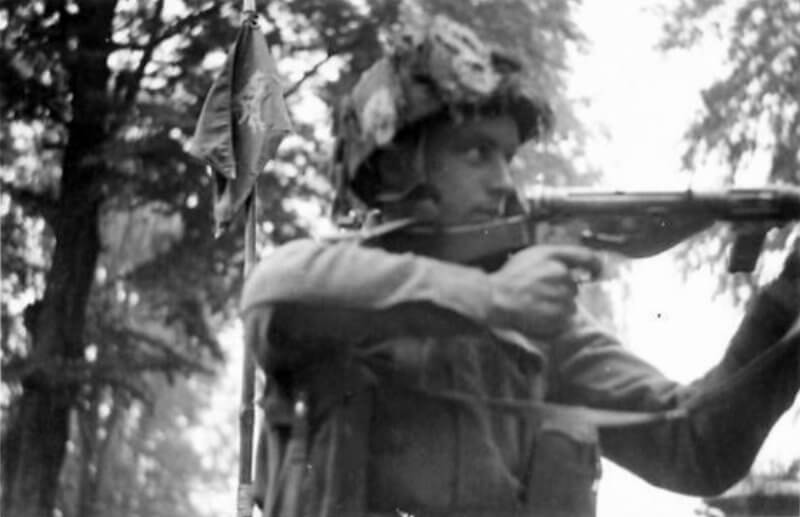| September 17th, 1944 – September 26th, 1944 |
| Operation Market Garden |
| Objectives |
- Land at Landing- and Drop Zones at Wolfheze, Oosterbeek, and Ede.
- Capture the road bridge in Arnhem and hold it for a minimum of 48 hours
- Link up with the advancing ground forces of the 30th Corps.
| Operational Area |
Arnhem Area, The Netherlands
| Allied Forces |
- 1st Airborne Division
- 1st Polish Independent Parachute Brigade
- 52nd, (Lowland) Airlanding Division
| Axis Forces |
- II SS-Panzer-Corps
- 9. SS-Panzerdivision “Hohenstaufen”
- 10. SS-Panzerdivision “Frundsberg”
- Kampfgruppe von Tettau
- Feldkommandantur 642
- SS-Unterführerschule Arnheim
- Bataillon I
- Bataillon II
- Bataillon III
- SS-Polizei Schule
- SS-Ausbildungs und Ersatz Bataillon 4
- Bataillon I
- Bataillon II
- SS-Wach Battalion 3
- Schiffsturm Abteilung 10
- Schiffsturm Abteilung 6/14
- Fliegerhorst Battalion 2
- Fliegerhorst Battalion 3
- Artillerie Regiment 184
- Sicherheit Regiment 42
- Kampfgruppe Knoche
- Sicherheit Regiment 26
- Bataillon I
- Bataillon II
- MG Bataillon 30
- FlaK Abteilung 688
- Bataillon I
- Bataillon II
- Hermann Göering Schule Regiment
- Hermann Göering Schule Regiment
- Bataillon I
- Panzer Abteilung 224
- SS Ersatz Abteilung 4
- Deelen Airfield FlaK Kompanie
- Wach Kompanie
- Reichs AD
- Hermann Göering Schule Regiment
- Sicherheit Regiment 26
- Kampfgruppe Kraft
- SS-Panzer Grenadier Ausbildungs und Ersatz Bataillon 16
- Schwerepanzer Abteilung 506
- Schwerepanzer Kompanie Hummel
- StuG Abteilung 280
- Artillerie Regiment 191
- Bataillon I
- Bataillon II
- Bataillon III
- SS-Werfer Abteilung 102, Hauptsturmfürer Nickmann
- Kampfgruppe Brinkmann
- Kampfgruppe Bruhn
- Kampfgruppe Harder
- Sperrverband Harzer
- MG Bataillon 47
- Marine Kampfgruppe 642
- Kampfgruppe Schörken
- Kampfgruppe Kauer
- SS-Abteilung “Landstrum Nederland”
- Kampfgruppe Knaust
- Ersatz Abteilung Bocholt
- Panzer Kompanie Mielke
- Kampfgruppe Spindler
- FlaK Abteilung Swoboda
- Kampfgruppe von Allworden
- Kampfgruppe Weber
| Defence of the Perimeter |
Divisional Headquarters is under sustained shell and mortar fire from 08:00 on. Both the unrelenting artillery fire and heavy rain set the tone for the fighting throughout the day around the Hartenstein.
The 17-pounder anti-tank gun, protected by Glider Pilots, positioned at the junction of Hoofdlaan and Utrechtseweg is shelled by mortars and ammunition running low. As the day’s bombardment intensifies, the truck, loaded with ammunition, takes a direct hit and is destroyed. The crew suffers serious casualties from this.
Brigadier Hackett spends much of the day visiting the units under his command, including D Squadron, The Glider Pilot Regiment and the 21st Independent Parachute Company, which are holding the eastern flank of the perimeter. Throughout the night, German forces attempt to infiltrate the British lines, particularly around the Main Dressing Station. By morning, a large-scale attack is launched against D Squadron. British artillery from XXX Corps is called in, breaking up the German assault, but the defenders are running dangerously low on PIAT bombs, leaving them vulnerable to German armour. The Germans use this advantage to bombard British-held houses, forcing the defenders to withdraw to trenches in nearby gardens.
In the southern part of Oosterbeek, Lieutenant Mike Dauncey of Lonsdale Force continues fighting near the old church on the riverbank. Determined to strike back after losing several comrades, Dauncey leads a patrol that ambushes a group of German soldiers, capturing eight prisoners. However, as they return to their lines, German mortars open fire, wounding several men, including some of the prisoners. Despite the casualties, the patrol manages to gather German weapons, including machine guns and pistols.
On the western side of the perimeter, the remaining men of the 1st Battalion, The Border Regiment face increasingly intense attacks from Kampfgruppe von Tettau. Both A and C Companies bear the brunt of the German assaults, which are supported by self-propelled guns and flame-throwing Panzers. Running out of ammunition, the men of A Company strip weapons and supplies from German dead, using them to fend off further attacks. Despite being cut off from the rest of the battalion, D Company holds its ground, fighting on against overwhelming odds.
16 Flight, Glider Pilot Regiment repels five separate assaults by German forces. In one attack, a self-propelled gun is destroyed by two well-placed shots from the 6-pounder guns.
As night falls, Brigadier Hackett convenes a meeting with his key commanders, including Major Geoffrey Powell of 156th Parachute Battalion and Major Wilson of the 21st Independent Parachute Company. They agree that a shortening of the defensive line is necessary. Under the cover of darkness, the units withdraw from their exposed positions and move into houses between Paul Krugerstraat and Utrechtseweg, despite some of these houses being held by German forces. The retreat is coordinated with support from XXX Corps artillery, which targets German movements near the MDS crossroads.
| German Reaction to the Landing of the Remainder of the 1st Polish Independent Parachute Brigade |
The remainder of the 1st Polish Independent Parachute Brigade, along with additional forces from the 82nd Airborne Division lands near Overasselt in the NIjmgen area. In total, around 3,300 troops are deployed. The majority of the airborne troops landed are sent to Groesbeek to strengthen the position of the 82nd Airborne Division. The small contingent of the Polish paratroopers are transported by truck to reinforce their brigade in Driel. This are the men of the aircraft that reacted to the general recall of the 1st Polish Independent Parachute Brigade shortly after departing England due to adverse weather conditions.
German Field Marshal Walter Model, responsible for coordinating the German defense, anticipates that the Allies will alter their planned route of advance. He suspects they will attempt to enter the German Reich from the east of Nijmegen, bypassing the heavily fortified Westwall, which the Germans have been preparing to defend.
Model also believes that the Allies are preparing another large-scale airborne operation to revive their stalled offensive. His suspicions are heightened when airborne landings take place in the American sector near Overasselt, where elements of the Polish Parachute Brigade land.
Model interprets the landings of the 1st Polish Independent Parachute Brigade and elements of the 82nd Airborne Division as clear indicators that the fighting is far from over. However, German fears of a renewed Allied offensive are in stark contrast to the deteriorating reality on the ground.
| Communications with 1st Polish Independent Parachute Brigade and preperations for another crossing |
Meanwhile, at the signals office of the 1st Airborne Divisional Headquarters, the telephone operator continues to answer calls, occasionally informing callers that connections have been lost, likely due to damaged lines. The British wireless transmitter has made contact with XXX Corps, while the Polish transmitter continues trying to reach both the British “Roger” and the Polish “Cuba” from the 1st Polish Independent Parachute Brigade.
The Germans try to interrupt the radio transmissions with a loud “Achtung” and further instructions in German. It is unclear whether this is an attempt to disrupt communications or locate the transmitter. The tension in the room increases as explosions continue, and the sounds of the wounded are heard from the passage.
Despite repeated calls, there is no response from either “Roger” or “Cuba.” The chief of staff checks in, urging the operators to keep trying, stressing the importance of bringing the Brigade across the river that night. Several new boats have been constructed on the north side sides of the river during the day, while assault boats are being brought in at the Polish side of the river. In spite of that, the situation remains critical. The defenders’ numbers and ammunition are running low.
Fatigue takes its toll as soldiers, many of whom have been without sleep or proper food for days, struggle to stay alert. The atmosphere changes when contact is finally made with the 1st Polish Independent Parachute Brigade. Although the connection is weak and often interrupted, it is a significant development. General Urquhart arrives and establishes communication with “Roger.” Despite interference and attempts to disrupt the signal, contact is maintained between the Airborne Division and the Polish Brigade, leading to important decisions being made.
| Royal Air Force Resupply Missions |
When the 1st Airborne Division is not relieved by XXX Corps on September 22nd, 1944, the Royal Air Force resumes resupply operations. Seventy-three Short Stirlings and fifty Dakotas C-47’s from No. 38 Group and No. 46 Group head to Arnhem, this time with a stronger fighter escort. Despite the improved protection, flak continues to take a toll, with six Short Stirlings and two Dakotas C-47’s shot down, and half of the remaining aircraft suffering damage. Much of the supplies fall into German hands rather than reaching the British perimeter. On Sunday and Monday, Dakotas of 575 Squadron, specially relocated to Belgium, fly a limited number of sorties to Arnhem. Although only one aircraft is lost, the supplies once again fail to reach their intended recipients.
| Second Crossing of the River Rhine |
The failure of the previous day’s attempt to use rubber dinghies for reinforcing the 1st Airborne Division north of the Rhine leads to the realization that these craft are impractical for the operation. In response, Major-General Sosabowski sends his chief of staff, Major R. Malaszkiewicz, south to request proper assault boats. Malaszkiewicz reaches the headquarters of the 130th Infantry Brigade and secures a promise of eighteen large boats, capable of carrying twenty-four men each, to arrive by 20:00 with Canadian sappers assigned as crew.
However, Malaszkiewicz returns to Driel around 19:00, necessitating a quick plan. Captain Budziszewski’s Engineer Company is tasked with organizing the crossing, with sappers providing security on the north bank. The 3rd Parachute Battalion is scheduled to cross first, followed by Brigade Headquarters and other units. Despite the plan, the boats do not arrive until just before midnight, and no crews are provided, forcing the Engineer Company to operate the boats themselves under heavy German fire.
The first crossing begins at 03:00 on Sunday, delayed by the need to move the boats 450 metres over difficult terrain. Further complications arise when it is discovered that the boats can only hold twelve men, requiring rapid reorganization. Despite the challenges, the boats make their way across the river, zigzagging to avoid German fire, though not all attempts are successful.
Once across, the Polish soldiers are divided into groups and directed to various positions. Throughout the crossing, sappers work under constant fire to ferry the troops. The Polish work with the lack of external assistance and the challenges faced.
Lieutenant Colonel E. Myers of the 1st Airborne Division observes that the Polish troops are doing their best under the circumstances, noting their lack of training for river crossings and the absence of proper boats, which were not anticipated in the Arnhem plan. He also comments on their less-than-adequate seamanship.
By daylight, the crossings are halted, with only 153 men successfully ferried across, ninety-five from the 3rd Parachute Battalion, forty-four anti-tank gunners, and fourteen from Brigade Headquarters, far fewer than expected. Major General Sosabowski, who had crossed the Rhine, returns to Driel with the majority of his command.
| Multimedia |




















